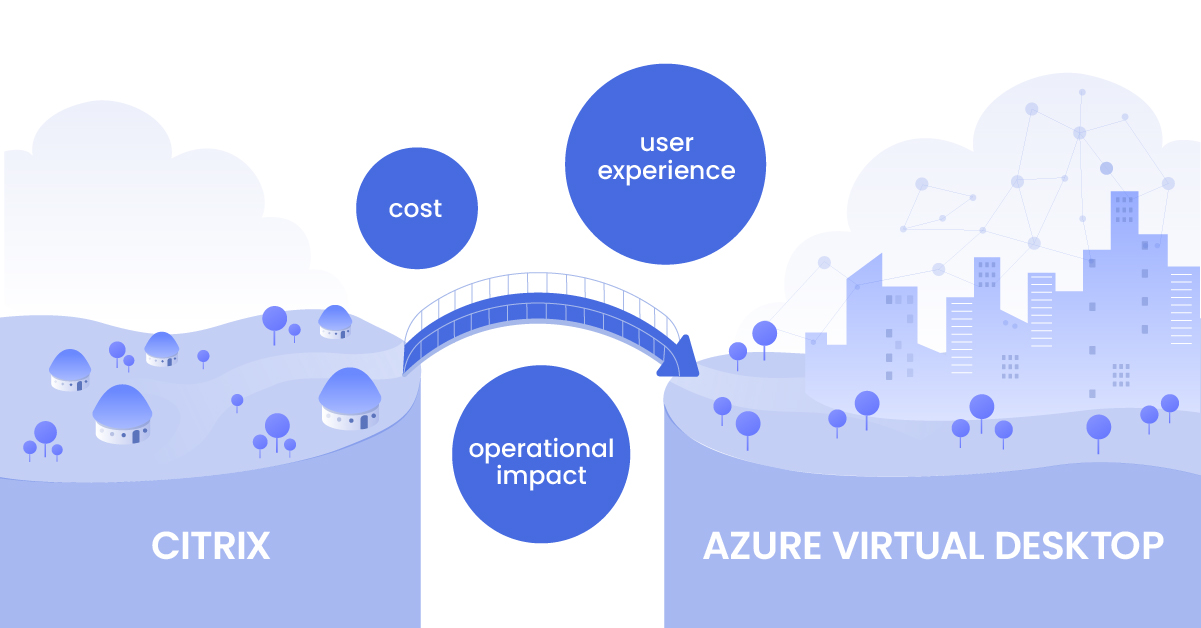
Worth moving from Citrix on-premise to Azure Virtual desktop?
Feb 6, 2024 6:14:20 PM
In the ever-evolving landscape of IT infrastructure, the transition from traditional on-premises solutions to cloud-based services is becoming more common and often necessitated by pivotal moments in hardware lifecycle management. For organizations operating on-premise Citrix environments, replacing significant hardware components – servers, storage, or network systems – frequently catalyses this shift.
Faced with investing in new hardware or embracing the cloud, these organizations encounter unique challenges and opportunities. This blog explores the complexities and advantages of migrating from an on-premise Citrix setup to Azure Virtual Desktop (AVD), offering key insights and considerations for IT management in this critical decision-making process.
On-Premise Virtual Desktop Infrastructure challenges.
Operating an on-premises virtual desktop infrastructure (VDI) based on Citrix presents a unique set of challenges that can significantly impact the efficiency and cost-effectiveness of IT operations. While Citrix offers robust desktop and application virtualization solutions, the on-premise model inherently brings complexities that demand careful management and strategic planning. This section will delve into some key challenges organizations face with their on-premise Citrix VDI setups. These challenges range from ongoing management costs to the resilience and backup of hardware, the intricacies of over-provisioning, and the complexities involved in managing various Citrix components.- Ongoing Management Cost: Managing both Citrix and the underlying hardware can incur significant costs, encompassing expenses related to maintenance, upgrades, and staffing. These ongoing expenditures can substantially impact an organization's budget and resources.
- Hardware Resilience: Physical hardware is susceptible to malfunctions and breakdowns, causing disruptions in server performance, storage functionality, network connectivity, and the overall efficiency of Citrix systems. These issues can result in substantial downtime and a significant decrease in productivity.
- Complex License management: You have both Citrix and Microsoft licenses, External Access licenses, NetScaler licenses and many other licensing
- Over-Provisioning: Predicting workloads can be challenging, often leading to over-provisioning of resources, which is inefficient and costly.
- Complex Citrix Component Management: The Citrix environment comprises multiple components like Citrix Virtual Apps and Desktops, Citrix Hypervisor, Citrix Gateway, and Citrix ADC, each requiring specialized management.
Benefits of Azure Virtual Desktop
Transitioning to Azure Virtual Desktop (AVD) from an on-premise Citrix setup opens the door to many benefits that can transform how organizations manage their virtual desktop infrastructure. AVD, a cutting-edge solution by Microsoft, is designed to streamline and enhance various aspects of virtual desktop management and user experience. This transition signifies a technological shift and represents a strategic move towards more efficient, secure, and scalable IT operations. In this section, we will explore the key benefits that AVD offers, ranging from fully managed backend services and rapid elasticity to cost efficiency, robust security, and an enhanced user experience.
- Fully Managed Backend Services: AVD provides a mix of IaaS, PaaS, and SaaS, eliminating the need for hardware deployment and maintenance. Azure handles all connectivity aspects, including load balancing, gateway services, Bios updates, and many more tasks.
- Rapid Elasticity and Scalability: AVD can seamlessly adjust to changing workloads and fluctuations in the workforce, guaranteeing a consistently optimal performance for users.
- Cost Efficiency: The transition to Azure Virtual Desktop (AVD) brings about a significant shift from capital expenditure (CAPEX) to operational expenditure (OPEX). With AVD, you only pay for the necessary resources, thanks to intelligent resource allocation. Moreover, many organizations already have AVD licenses in their Microsoft 365 E3, E5, F3, and Business Premium Licenses. Additionally, Azure's advanced analytics and monitoring tools are crucial in optimizing resource usage, further reducing costs.
- Built-in Security and Privacy: Azure’s foundation is inherently secure, offering advanced features like multi-factor authentication, role-based access control, and network segmentation. Compliance with international and industry-specific standards is streamlined and supported by comprehensive compliance tools.
- Enhanced User Experience and Productivity: AVD provides a seamless gateway to Microsoft 365 services and other Azure-hosted cloud services, offering users an immersive Windows 10 or 11 experience that surpasses the limitations of a Citrix server setup. With the added advantage of Azure's high-performance computing resources, Office applications run smoothly and efficiently. Whether located in the same data centre or connected through a fast fibre link, users can enjoy a fully functional and transparent Office experience powered by Azure's cutting-edge technology.
Conclusion
Migrating from an on-premise Citrix environment to Azure Virtual Desktop represents a strategic move towards a more efficient, secure, and user-friendly virtual desktop infrastructure. The transition addresses the inherent challenges of on-premise setups and leverages Azure's advanced capabilities to enhance organizational productivity and agility. As IT management navigates this shift, understanding these benefits is crucial in making informed decisions that align with long-term business objectives.
If you want to get a view on the Financial and operational aspect moving, you may benefit from our Citrix to Azure Virtual desktop assessment.
Submit a comment